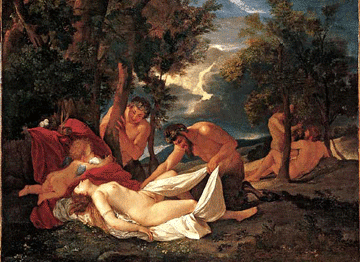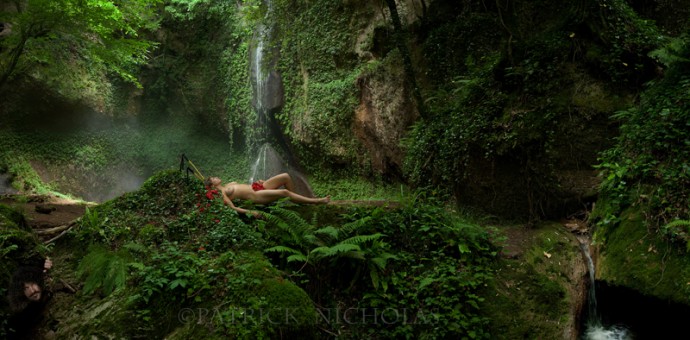Arcadia
Nicolas Poussin the Frenchman and I have one thing in common, like him I have spent most of my adult life in Italy and we arrived at about the same age. The Rome he found in 1625 was however very different from today’s, with a population of little more than 100,000 – more of a town than a city and moreover it was not only surrounded by an idyllic rural landscape scattered with Roman ruins, the Roman Campagna, but was rural within too. Cows wandered in the ancient Forum, hare and even deer and were not uncommon, sheep grazed around The Vatican. Rome was a place evocative of Arcadia itself, with its colossal wrecks overgrown and and half buried, reminders of a a glorious past alongside the beauties of the modern, Christian, Rome hugger mugger with mediaeval squallor. It may have been little bigger than a town but it was the capital of an empire, the heart of catholicism. Imperial Rome did not so much fall as shed its secular power to become the greatest religious power on earth attracting not only pilgrims but artists from all over Christendom.

Poussin: Nymph with Satyrs. 1627 there are 2 versions one in the National Gallery, London; the other at Kunsthaus, Zurich
The curious thing about catholicism since the Renaissance was its willingness to absorb pagan mythology. Poussin painted more mythological scenes than biblical, he was particularly interested in Pan, or rather his patrons were. What was it that drew these powerful prelates to the most licentious of Greek myths? Some of them may even have demonstrated some Christian qualities, but a Cardinal was first and foremost a prince who wielded considerable power, distributed largesse and had not got where he was without considerable wiliness and intrigue – perhaps there was something about Pan that struck a chord with the instincts of the jungle.
My model was a twenty-one year old American studying Art in an American Academy in Orvieto. I showed her Poussin’s painting ‘Sleeping Nymph with Satyrs’ and we agreed to do a sort of prelude to the scene, in which the nymph is being observed by Pan.
The morning of the shoot she came in to the gallery looking troubled and I felt immediately that the appointment was about to be broken. She showed me a letter she had received from her college, the college authorities in Massachusetts had effectively forbidden her to take part. “…..In this case, the erotic charge of of Mr Nicholas’s photography is incompatible with the specific character of the College in Orvieto program as well as with the scriptural principles governing the College as a whole, and with the behavioral expectations upheld by the many other sister Christian liberal arts colleges who entrust their students to four months under our care in Italy.”
I was reminded of a line from one of my favourite books, 1066 and All That ,‘The Cavaliers were wrong but romantic, the Puritans right, but repulsive.’ *
The college said ‘no’ but she, though fearful, said yes. We went three of us, a girlfriend of hers accompanied us to assist, to one of my favourite places – a place I call the Sacred Glade. A magical place, sacred to the Etruscans, then Christianised, then abandoned, it is hard to get to and involves a half hour hike – with all the equipment under the noonday sun. We picked poppies on the way, they would feature in the picture. After trekking across fields we entered the green gloom of a wood alongside the river Fiora, then after rounding a bend under high cliffs a dell opens up in front of us, a high waterfall cascades over a black rock, the girls are enchanted. The assistant busies herself with a bee gun to make smoke to add mistiness and highlight the sun’s rays – the smell of incense adds an unexpected element of sacrality.
This is Pan’s place, an unspoilt Arcady of the sort that Poussin would have found not only in the Alban Hills just outside Rome but also in grottoes and caves within walking distance of the Pantheon. The river that flows, very often underground, through Arcadia is Alpheus, and here too the stream plunges from up on high from the light, down into the shades. Pan is the god of opposites, of courage and fear, of standing and fleeing, of love and rape, instinct and free will, introvert and extrovert, Cavalier and Puritan, top half man lower half beast, he is all the contradictions which make us human.
The semi concealed figure in the foreground is Pan or perhaps Poussin, or perhaps a Puritan?
The following day she and her friend came to the gallery looking gloomy – she had been expelled that afternoon, and was flying home early the next morning. She wept, more with anger than sorrow. The authorities had not even seen the picture but perhaps by their terms they were right, she had after all been told no and she had cocked a snook.
We have remained in touch and she seems to have grown from the experience.
“She had not known the weight until she felt the freedom.”
– The Scarlet Letter, Nathaniel Hawthorne
Backstage notes. Camera: Canon 5D, 75mm zoom lens, 320ISO. This a stitch of half a dozen vertical shots so it’s a very big file and in fact I’ve done some very large prints as a result. I use a geared panoramic tripod head with a levelling device so pans of this sort are straightforward. The model’s girlfriend was behind the grassy knoll frantically puffing away making smoke with the bee-gun to make a bit of hazy mist in the background.
The Puritan – or Pan – bottom left, is a a Frenchman I met in 2008. He had such a wonderful face, hair and beard – pure Cardinal Richelieu I thought at the time. I asked to photograph him thinking that he might well come in useful at a later date.


you write it beautifully and it draw my attention to the articles.
Thank you so much for your positive comment. As you will probably have gathered I’m only just starting to blog my work but I’ll be putting up companion articles and musings about more of my work soon – I’ll always be grateful for comments and criticism in the future.
Patrick